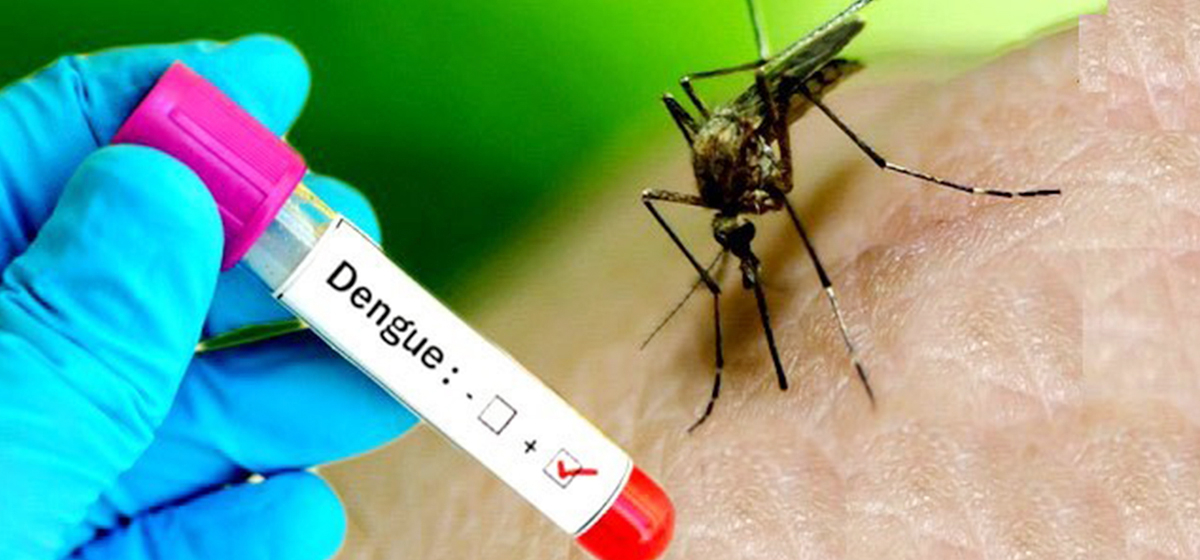
Increased rainfall and humidity create optimal conditions for mosquito breeding
KATHMANDU, July 8: Dengue has rapidly emerged as a significant mosquito-borne viral disease, causing serious issues in Nepal's lowland areas since 2006. With the onset of the monsoon season, ideal conditions for mosquito breeding and virus transmission have led to an increase in dengue fever cases throughout the several regions of Nepal. This trend reflects a global rise in dengue incidence over recent decades.
The monsoon rainfall leads to the formation of stagnant pools of water, ideal breeding grounds for Aedes aegypti mosquitoes. Factors such as the presence of stagnant water in artificial containers like tires, flower pots, and water storage vessels, and climate change contribute significantly to the production and spread of Aedes mosquitoes, which are the primary vectors responsible for transmitting the dengue virus to humans through their bites.
Since the onset of heavy rainfall in June, a surge in dengue fever cases has been reported. The first case of dengue fever in Nepal was reported in 2004. During the monsoon season, a significant number of dengue cases, alongside 32 laboratory-confirmed cases, were reported throughout hospitals in central and western Terai, as well as Kathmandu in 2006.
Since 2010, dengue epidemics have continued to impact the lowland districts and extending into mid-hill areas This trend of increasing magnitude has continued with outbreaks reported annually in various districts such as Chitwan, Jhapa, Parsa, Rupandehi, Mahottari, Kaski, and Sunsari.
Moreover, on July 7, the government officially gazetted Dengue in the list of 52 infectious diseases, as per Section 49(1) of the Public Health Service Act, 2075.
According to government statistics, Nepal experienced its largest ever dengue outbreak in 2022, with 52,790 cases reported from all seven provinces and affecting all 77 districts of the country.
As of June 9, 2024, there were over 1130 cases of dengue reported in 71 districts of Nepal, with most cases i.e 114 cases reported in Kathmandu, followed by 111 cases in Jhapa. The first case of dengue was reported from Chitwan district in 2004. Dengue fever is seen mostly in the terai region.
The increase in dengue fever after monsoon rains is not just limited to Nepal alone; it's a phenomenon observed in many regions of the world where dengue is endemic.
Dengue fever spreads worldwide during monsoon season
Since the beginning of 2024, over 10 million dengue cases and over 5,000 dengue-related deaths have been reported from 80 countries. The disease is now endemic in more than 100 countries in the regions of Africa, Americas, Eastern Mediterranean, South East Asia and Western Pacific. The region of Americas, South East Asia and Western Pacific are the most seriously affected. The number of dengue cases has increased dramatically in countries like India, Sri Lanka and Indonesia in this region.
Causes
Dengue fever is caused by the dengue virus, which is transmitted to humans through the bites of infected Aedes mosquitoes. Stagnant water where mosquitoes breed, climate change, and global travel contribute to its spread. These mosquitoes become infected when they bite a person already infected with the dengue virus. The virus circulates in the blood of infected humans and can be transmitted to mosquitoes when they feed on the infected person.
Symptoms
As the monsoon season approaches, the propensity of dengue fever significantly increases.
Dengue can cause symptoms ranging from mild flu-like signs to severe life-threatening complications. With no specific treatment or widely available vaccine yet, prevention emerges as our most potent weapon against the disease. It causes high fever, severe headache, pain behind the eyes, joint and muscle pain, fatigue, nausea, vomiting, skin rash, mild bleeding and others. These symptoms usually appear 4 to 10 days following a bite from an infected mosquito. Individuals who are infected for the second time are at greater risk of severe dengue.
Similarly, severe dengue symptoms often emerge after the fever subsides, marking a critical phase in the illness. During this period, patients may experience severe abdominal pain, persistent vomiting leading to dehydration, and various forms of bleeding such as nosebleeds, gum bleeding, and tiny skin hemorrhages. Breathing difficulties can arise due to fluid accumulation in the lungs, extreme fatigue and restlessness.
Prevention and control
Currently, there is no specific antiviral treatment for dengue. Therefore, medical care primarily focuses on managing symptoms and preventing complications. There are several steps we can take to prevent and control dengue and protect ourselves. The most crucial measure is to actively control mosquito populations in and around our homes. We can reduce the risk of contracting dengue fever by using mosquito nets or screens on windows and doors as well as wearing clothes like long sleeves and pants which covers as much as our body and applying mosquito repellents.
Likewise, mosquito breeding can be prevented by eliminating artificial water collections where mosquitoes breed. These include items like broken pots, tires, garbage containers, flower pots, and boxes.
Furthermore, dengue fever presents a significant global health challenge due to its widespread transmission via mosquitoes. Despite efforts in mosquito control and public education, there is no specific antiviral treatment or fully effective vaccine available yet. Efforts are crucial to manage this disease, focusing on research, prevention, and raising public awareness to mitigate its global impact.


Leave A Comment